Guitar history: from spanish and classical to electric guitar
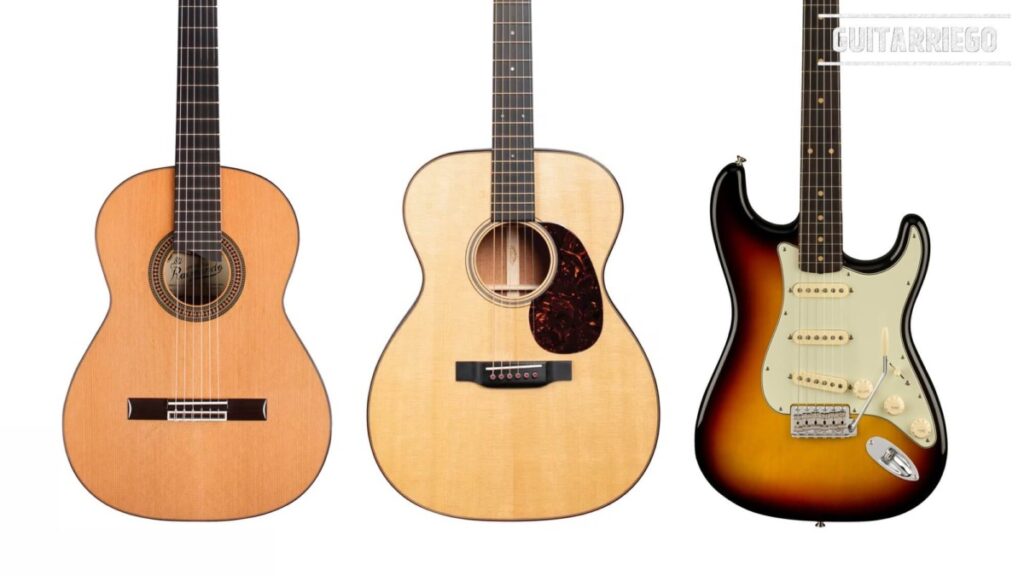
History of the guitar: birth, evolution and changes, the most popular brands and models, their characteristics and much more information.
Guitar, the musical instrument
The guitar is a musical instrument of the family of stringed instruments and today it is the most popular instrument in the world.
The Spanish or classical guitar, as its name indicates, was created in Spain. However, there are many antecedents to it in many civilizations. String instruments were widely used in a large number of cultures. Among these cultures is the Arab that invaded the Iberian Peninsula in the 8th century, precisely the cradle of the guitar, Spain.
The Greeks also had an instrument with a similar appearance to the current guitar, although with straight edges and 4 strings, which was later adopted and modified by the Romans, who brought it to Spain around 400 BC. On the other hand, there are even older documents that show that at the time of the Hittites, 1,300 BC, there was already an instrument also with 4 strings that had curved edges. And another example is the Egyptian culture, who had a guitar-like instrument with smooth, curved sides.
Types of guitars
There are several types of guitars. The best known are i) the Spanish guitar, which includes classical and flamenco, ii) the acoustic guitar, which includes electro-acoustic, and iii) the electric guitar, which not only includes solid-body guitars, but also hollow– and semi-hollow body guitars.
If you want to go deeper into the subject, visit this excellent guide on types of guitars: characteristics and differences between the classical, acoustic and electric guitar.
Beginnings of the guitar: the Spanish guitar
The modern classical guitar, as it is known today, appeared in the 19th century. This instrument, also called the Spanish guitar due to its origin, was the basis from which the modern electric guitar emerged.
What is the guitar?
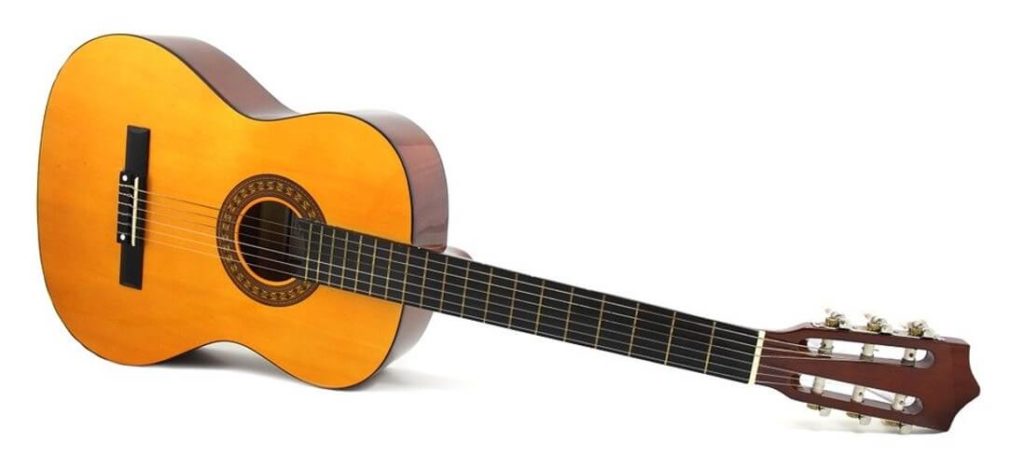
The guitar is a plucked string musical instrument, composed of a body -sound or resonance box-, a neck on which the fingerboard or fretboard is attached, and six strings at least, but it can have seven, eight or more strings, or six double strings, what would be a twelve-string guitar.
The body is composed of a top / soundboard, sides and back. The sound cap or top amplifies sound, and usually has a round acoustic hole in the center of it called the soundhole.
Characteristics of the classical or Spanish guitar
The classical guitar, also known as the Spanish, nylon-string guitar, is the traditional, historical, and most popular version. There are also variants such as the flamenco guitar, but at first glance they are very similar instruments.
History: The predecessors of the Classical or Spanish Guitar
To start talking about the history of the guitar, we must start with its predecessors. The instrument derives from the vihuela and the Spanish guiterna of the 15th and 16th centuries, from which later emerged the baroque guitar of the 17th and 18th centuries and then the modern or Spanish classical guitar of the mid-19th century.
Below you can see a Spanish guitar -top left-, a vihuela -bottom left- and a baroque guitar -right-:

If you are learning to play the guitar, we recommend this selection of the best easy Country songs for beginners to play on classical or acoustic guitar.
Antonio de Torres Jurado, the inventor of the Spanish or Classical Guitar
Antonio de Torres, known as the “Father of the guitar”, is recognized as the luthier who invented the current guitar, that is, the Spanish guitar, both flamenco and classical. De Torres is to the guitar what Antonio Stradivari was to the violin.
Vicente Gomez Martinez Espinel
Better known as Vicente Espinel, he was a Spanish priest, writer and musician of the Spanish Golden Age, in 1500 AD, responsible and famous for giving the guitar its fifth string, adding a lower string to the four existing at that time.
Classical guitar construction
Classical guitar does not have a single nail and all the pieces are joined using glue. The body consists of a top, back and sides. The sides are soaked and with heat they are given that curved shape so characteristic of the instrument. To reinforce the soundboard, a spruce pine bracing is made. Bracing also fulfills an acoustic function by helping to ‘drive’ the vibrations within the soundboard producing the characteristic sound. Likewise, the back is prepared by placing the cedar bars which give a slightly convex shape to this part of the guitar.

Ussually, the neck that has five pieces placed under a specific configuration to form the heel and the proper angle of the headstock. Also, the fingerboard can be made from ebony, walnut, or other tonewoods.
The top is joined to the neck, and the guitar is assembled by stuffing the sides and joining the sides to the soundboard with sockets -small triangles of spruce pine-. The bindings and rosette are added. Really all a craftsmanship and meticulous the process of construction of the guitar.
What woods are classical guitars made of?
Classical guitars are usually made with woods such as cedar and rosewood, ebony, and spruce but you can also find instruments made of cypress, walnut, coco bolo, redwood, nazarene, ziricote or maple wood, among other.
What material are classical guitar strings made of?
Historically, the first three strings -the thinnest- were made from ram gut, these are single strings. The other three are wound strings, they were metal snares wound on a silk thread.
The gut was used until the 20th century, when nylon was introduced. Regarding the snares, a metal thread wound on a silk or synthetic material core is still used.
Acoustic guitar
The acoustic guitar is very similar to the classical guitar, but instead of having nylon strings, all its strings are made of metal, precisely steel. Another difference between the two instruments lies in the size of the body and the length of the neck. Thus, the acoustic guitar is usually larger, and there are several models depending on its size. On the other hand, the neck of the acoustic is narrower than that of the classic at the height of the nut.
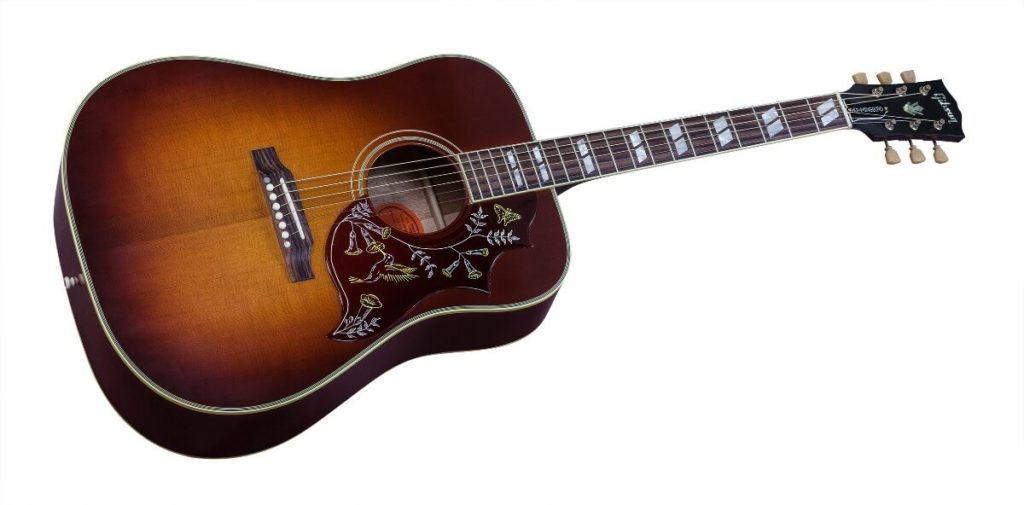
Don’t miss our pick of the best acoustic guitars for beginners: good and cheap.
Electric guitar
The electric guitar is a metal-string guitar that uses the principle of electromagnetic induction to convert the vibrations of its metal strings into electrical signals.
Its appearance is due to the need of the musicians, more precisely the jazz bands in the United States during the 1920s, to have a greater volume so that it would not be lost in front of the rest of the musical instruments, and in this way it will gain more relevance.
History of the electric guitar
The origin of the electric guitar takes us back to the 1930s, when George Beauchamp, an American inventor of musical instruments, began looking for new ways to increase the volume of the guitar.
As early as 1925, Beauchamp had experimented with the use of phonograph stylus to produce an electric guitar, and knew that if a device could pick up the vibrations of each individual string, and convert those vibrations into a proportional variation in electric current then the sound could be amplified.
The first manufacturer of electric guitars
After many months of trial and error, Beauchamp and Paul Barth developed a prototype guitar with horseshoe magnets. The guitar strings were passed through the magnets with each pole positioned so that an independent magnetic field was concentrated on each string.
Beauchamp, with the prototype in hand, went to Adolph Rickenbacker, an electrical engineer, to manufacture the metal bodies of the resonators. From this meeting, the foundation of the famous company “Rickenbacker Instruments” later arose.
Rickenbacker «Frying Pan», the first «Lap Steel Guitar»
In 1936, the company began manufacturing the first Lap Steel Guitar, called “Frying Pan“, which quickly gained popularity. In this way it was the first manufacturer of electric guitars in the history of the guitar.

Also, check out this selection of the world’s rarest, most collectible, and most desired electric guitars.
Lloyd Loar and Vivi-Tone
In the early 1920s, Lloyd Loar, a legendary acoustic engineer for Gibson Mandolin-Guitar Mfg. Co, Ltd. for his contributions to the design and development of the mandolin, had experimented with amplification in guitars. So it was that in 1933 he founded, along with Lewis A. Williams and Walter Moon, a company called Vivi-Tone.

Although the company came up with many innovative ideas in instrument design, it was ultimately not commercially successful. The company produced guitars, mandolins, an electric keyboard, and at least one amplifier.
Gibson and his first Spanish electric guitar, the ES-150
Despite the failure of Vivi-Tone, Gibson capitalized on Loar’s failed experience to create an electric guitar that would revolutionize the market and mark a milestone in the instrument’s history, the Gibson ES-150.
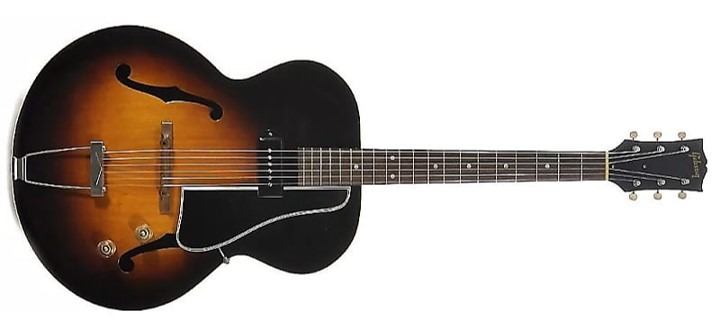
The ES-150 guitar was released in 1936. The name of this guitar was short for Electric Spanish -Guitar- and the 150 was for the retail price of $ 150.
This guitar, based on the historic L-5 which was the first guitar made by Gibson. The ES-150 was a huge commercial success, receiving wide acceptance among Jazz and other styles guitarists. However, the instrument still had some features to improve. Hollow body vibrations were picked up and amplified, creating feedback problems, distortion, and undesirable overtones.

Les Paul and “The Log”
Lester William Polsfuss, known a Les Paul, was a virtuoso and famed American jazz, country, and blues guitarist. Les Paul was a very important figure in the development of electric musical instruments and recording techniques.
This jazz musician believed that the solution to the problems of contemporary electric guitars, such as the ES-150, was to use a solid body instead of a hollow body.
In 1940, Les Paul created a prototype instrument, a guitar called “The Log”. This guitar was built with a solid wood body. Interestingly, the guitar “The Log” was built by the musician at the Epiphone guitar factory.
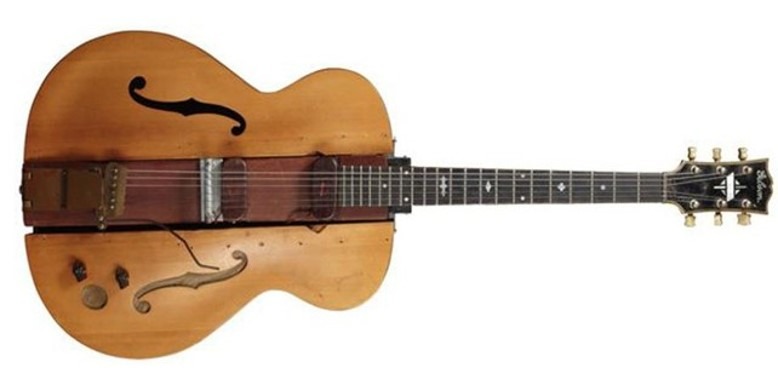
It consisted of two Les Paul built magnetic single pickups, mounted on a 4 x 4 plank of wood, gluing the two solid halves of the body together as “wings” to the sides. The result was a good sounding jazz instrument without unwanted feedback.
You might be interested in learning about the birth story of the Gibson vs. Fender rivalry.
The first solid-body electric guitar made of wood?
Many believe that “The Log” was the first solid body guitar, however, it is difficult to say that this is the case. During those years some examples of solid body instruments appeared -not so popular- and it is difficult to confirm with certainty that “The Log” was the first of all. There was even a Paul Tutmarc Audiovox electric bass in 1936.
“The Log” would be used by Les Paul both in his live performances and for his studio recordings with other artists such as Bing Crosby or The Andrew Sisters.
In 1946, Les Paul contacted Gibson who had just been acquired by Chicago Musical Instruments. He introduced his guitar with the goal of making a solid body guitar. But Maurice H. Berlin, the company’s president at the time, rejected the Les Paul idea, referring to the guitarist’s prototype as “broomstick” with the pickups on it, a decision they would later regret. In 1951, seeing the success of Fender guitars, Gibson would change his mind and Ted McCarty, president of the company and a great inventor, together with Les Paul they would develop the Gibson Les Paul.
The electric guitars of Paul Bigsby Merle Travis and others
Most players are familiar with the famous Bigsby Vibrato system, but not many are aware of the innovative guitars Paul Bigsby built in the 1940s. Bigsby, responsible for developing and refining the pedal steel guitar. In addition, he built the first modern solid-body electric guitar for Merle Travis in 1948, predating Leo Fender‘s Esquire and Telecaster, released in 1950, and Gibson‘s Les Paul guitar, released in 1952.
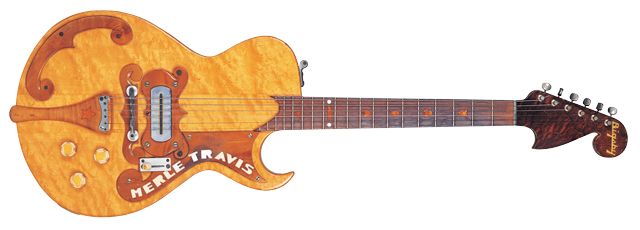
Looking at the guitars of Paul A. Bigsby the influence on the development of the modern electric guitar is evident. Not only Fender and Gibson, but also other guitar manufacturers, based and inspired on Paul‘s guitar construction and design techniques.
In 1948, Paul A. Bigsby built a custom solid-body instrument for Merle Travis, a well-known Country musician. In 1949, Bigsby built one for the Les Paul, although Les kept it a secret for many years, as with the Nocaster that Fender gave him.

We recommend that you also take a look at the free online guitar amp simulator options.
Fender Telecaster, the first mass-produced electric guitar
Contrary to what most believe, the first guitar Fender released was not the Telecaster but the Esquire. Thus, the Fender Esquire, a single-pickup version of the Telecaster, was the first mass-produced solid-body electric guitar model to be commercialized in history. Its launch was in 1950, and it was a resounding success.

The Esquire is the same as a Telecaster but comes with only one pickup, in the bridge. During the same year, 1950, Fender added a version with two pickups, called the Broadcaster. But shortly after a dispute with Gretsch who had a drum set with a similar name, Leo had to stop using it, thus beginning the “Nocaster” era of 1951. It is so named since it did not have a model name on the decal of the guitar.
In 1952, Fender‘s two-pickup guitars left the factory again with the model name on the decal, the name would now be definitive: Telecaster.

Main specifications and features of the Telecaster
The Telecaster typically has an Ash or Alder body, but pine, basswood, mahogany, and other woods are also used. The neck is bolted to the body, unlike earlier guitars which were glued-in. In this way it facilitates construction, reduces time and makes production cheaper. The neck and fingerboard are made of either a single piece of maple or maple with a rosewood fretboard.
The tone of the Fender Telecaster is characterized by its twang. Thus, the Telecaster is a guitar with a lot of attack, percussive, with brightness, and enough midrange. It is an ideal guitar for Country and Rock, and also used for Blues and Jazz in its traditional configuration. But it is a guitar widely used to modify, there are different versions with different configurations of pickups, bridges and even Thinline, which means that you can see a Telecaster being played by a guitarist of any style.
Not everything in the history of Fender were successes, Fender also had great failures with ugly, rare or misunderstood guitar models.
Gibson Les Paul: Gibson’s first solid electric guitar
As we said before, Gibson, attentive to the success of Fender, contacted Les Paul so that the musician would promote a solid body guitar that would bear the artist’s name.
Gibson Les Paul Standard Goldtop
The first model was the Gibson Les Paul Standard Goldtop released in 1952. With a mahogany body with a carved top from solid maple, to give more treble and definition to the rich midrange audio of the mahogany. The top was in line with the “arch top” guitars popularized by Gibson. The curved top was proposed by Maurice Berlin, the firm’s luthier. Gold finish was chosen by Les Paul himself.
The mahogany glued neck with a rosewood fingerboard and included an adjustable tension rod. Two singlecoil P-90 pickups made by Gibson since 1946.
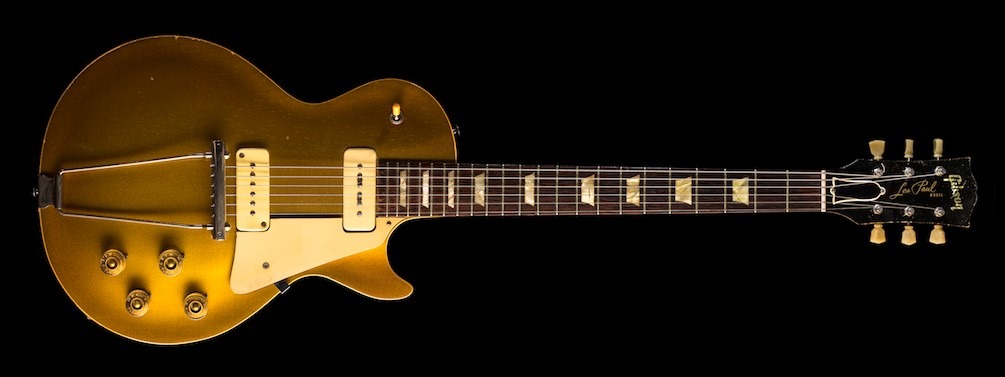
Gibson Les Paul Custom
Shortly after, in 1954, Gibson would modify some things on the guitar, such as the bridge and tailpiece and changes to the pickups. Also, he made a new model, the Gibson Les Paul Custom. Which was called “The Black Beauty“, which in addition to having aesthetic differences, such as block inlays, instead of the trapezoid, and double binding on the body and headstock, came equipped with an ebony fretboard.

Later in 1955, Seth Lover, a Gibson designer and inventor, creates the humbuckers known as PAFs. The name arises from the attached labels with the initials of Patent Applied For, since the application for the patent had been made.
You may be interested in our Gibson Golden Age article.
Gibson Les Paul Standard
In 1958, the Gibson Les Paul Standard appeared, with a Sunburst finish consisting of a translucent caramel base that allows the maple grain to be seen. In the first year of production, the maple tops were not so showy, until in 1959 the more showy flamed maple tops appeared.

The “Burst”, as the Les Paul Standard of the early years is called, are the most desired, especially those from 1959, which is considered the best year. The lacquer with which the “cherry” red edges were painted had the particularity that when exposed to the sun, it discolored. This is the reason for the different new finishes today, which do nothing more than replicate the finishes that vintage instruments took on when exposed to sunlight. Thus arise the “Tea burst”, “Dessert burst”, “Lemon burst”, among others.
Main specifications and features of the Gibson Les Paul
The Les Paul is a guitar that is characterized by having a rich tone in mids and low frequencies. The maple top is to give more high frequencies to the low and mid tone of the mahogany. Guitars with a rosewood fingerboard -the Standard- have a more “round” sound since it is a wood that is rich in midrange frequencies. While guitars with an ebony fretboard tend to have more brightness and definition and less mids. The latter is often used a lot for heavy styles, but it is also a great option for clean audio. On the other hand, the Les Paul with Rosewood fretboard is the most traditional, it is more used to play traditional styles.
If you want to know more about the Gibson Les Paul guitar and its evolution.
Fender Stratocaster
The Stratocaster is the best-selling electric guitar model in the world. This guitar was designed in 1954 by Leo Fender, Bill Carson, George Fullerton, and Freddie Tavares. The Fender Stratocaster was intended to be the natural evolution to the Telecaster.
The most relevant changes are: 1) a more ergonomic body with a softer contour and belly cut and arm cut that allows the instrument to fit better to the player body; 2) Tremolo bridge that on the one hand allows vibrato and at the same time, gives it a less aggressive sound and gives the sound a natural reverb due to the springs it uses; 3) Three pickups with a new design, which give two more possibilities of audio -five against the three of the Telecaster- and a rounder and softer sound. Thus, the bridge and pickups give the Stratocaster a “sweeter” audio compared to its predecessor, the Telecaster.

Main specifications and features of the Stratocaster
The Stratocaster guitar, like the Telecaster, usually has an Ash or Alder body, but basswood, mahogany, pine and other woods are also used. The neck bolts to the body and can be a single piece of maple, or maple with a rosewood fretboard.
You may be interested in knowing the best manufacturing years of the Fender Stratocaster and the worst ones to avoid.
The Holy Trinity of guitars
Thus, the first three models successfully launched: Telecaster, Les Paul and Stratocaster, make up a unique trilogy of electric guitars.
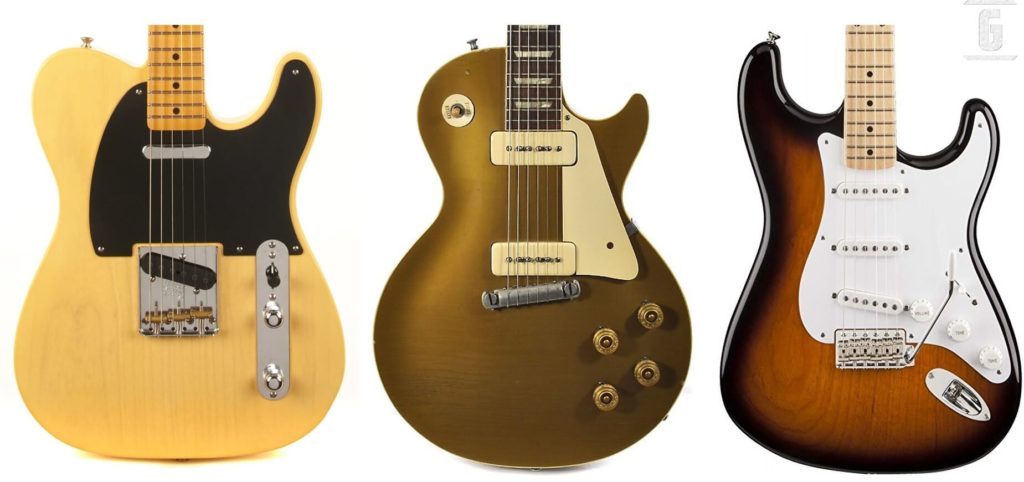
Other important historical guitar models
Then, during the following years, other important models have appeared. The most important are:
- Gretsch 6120, is a hollow body with “F” shaped holes introduced in 1955.
- Gibson ES-335 “Dot” was the world’s first commercialized semi-hollow body guitar, released in 1958.
- Rickenbacker 325, a small guitar -20.75″ scale- and semi-hollow. Released in 1958. It was one of John Lennon‘s first guitars.
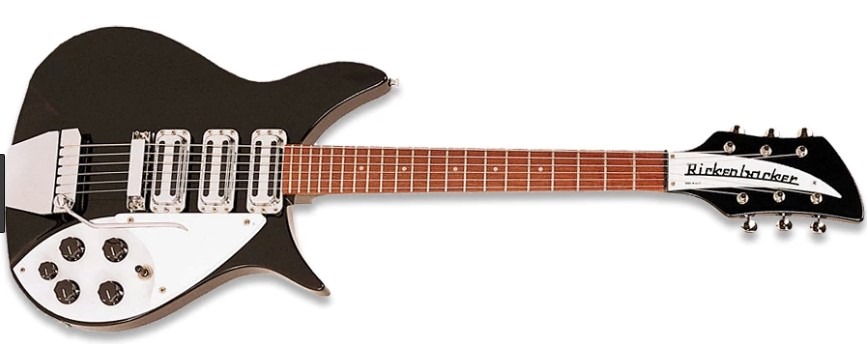
- Gibson Flying V, the first line was marketed for only two years, in 1958 and 1959. Its main characteristic is its arrow-shaped design. Along with the Gibson Explorer and Moderne it was part of a “futuristic” line that was released by Ted McCarty.
- Fender Jazzmaster, was the first offset guitar model, intended as the top-of-the-range version of Fender.
- Gibson SG, the initials mean “Solid Guitar“. This guitar was introduced to the market in 1960, initially as the new “Gibson Les Paul“. Its objective was to replace the Les Paul due to the drop in sales that it had suffered. It was conceived looking to make a more modern, cheap and light instrument, since the Les Paul was very heavy, expensive and “outdated” for the market.
- Fender Jaguar, introduced in 1962, is based on the Jazzmaster, with the same body and tremolo system but a shorter 24″ scale.

Most popular brands of electric guitars
There are countless manufacturers and brands. Here, we show you the best-known brands of electric guitars are:
- Fender
- Gibson
- Ibanez
- Paul Reed Smith -PRS-
- Gretsch
- Yamaha
- Jackson
- ESP
- Epiphone
- Squier
- Musicman
- Fano
- Sammick
You may be interested in our note on the best electric guitar brands.
The best guitarists in history

Below we show you a list of the most recognized and influential guitarists in the history of Rock and his favorite guitar and amplifier -if he used many, he took the most representative one-:
- Jimi Hendrix: Fender Stratocaster and Marshall Super Lead
- Stevie Ray Vaughan: Fender Stratocaster and Fender Super Reverb
- Steve Vai: Ibanez JEM and Carvin Legacy
- John Lennon: Rickenbacker 325 and Vox AC30
- Slash: Gibson Les Paul and Marshall Silver Jubilee
- Angus Young: Gibson SG and Marshall JTM-45
- Tony Iommi: Gibson SG and Laney Iommi
- Frank Zappa: Gibson SG and Carvin X-100B
- Gary Moore: Gibson Les Paul and Marshall JCM2000
- Eric Clapton: Fender Stratocaster and Fender Twin or Marshall Bluesbreaker
We also recommend that you read our note on the 10 facts about the guitar that will surprise you.






